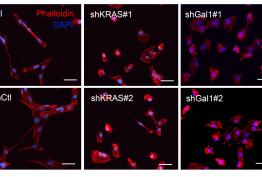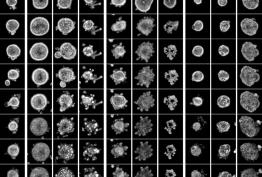Cardiovascular diseases are one of the main causes of mortality worldwide, being responsible for some 18 million deaths each year. In Spain / Catalonia they represent almost a third of deaths. These diseases also cause a significant decrease in quality of life. An international team of multidisciplinary researchers led by Professor SRW Chen from the University of Calgary, the Cardiac Rhythm and Contraction group at the Institute of Biomedical Research of Barcelona IIBB-CSIC and IIB Sant Pau, the research group of Computational Biology and Complex Systems BIOCOM-SC and the ANCORA group of biomedical images analysis at the Universitat Politècnica de Catalunya · BarcelonaTech (UPC) have identified one of the molecular mechanisms underlying cardiac alternans, an alteration of the heart rhythm that facilitates the induction of ventricular fibrillation1, a potentially fatal arrhythmia. Furthermore, they show that people with loss of ryanodine receptor (RyR) function are prone to induction of ventricular fibrillation and sudden death caused by cardiac alternans2.
Cardiac alternans have been known since the late nineteenth century, when an alteration in the pulse (hence the name pulsus alternans) was described, alternating a strong heartbeat with a weak one. Almost a century later, this alteration was related to the propensity to suffer episodes of ventricular fibrillation, where heart cells suddenly stop beating in a synchronized way, in many cases with fatal results in just minutes. Since then, work has been done to understand the molecular mechanisms responsible for this arrhythmia, which would open the doors to the development of possible pharmacological treatments.
Background for the study of alternans at IIBB-CSIC and IIB Sant Pau
The Cardiac Rhythm and Contraction group at IIBB-CSIC and IIB Sant Pau, led by Dr. Leif Hove-Madsen, has been studying cellular electrophysiological alterations responsible for the induction of cardiac arrhythmias for two decades. However, the molecular mechanism responsible for cardiac alternans has been the subject of debate over the past decade where different origins for RyR malfunction have been proposed. As Dr. Leif Hove-Madsen points out, “The ryanodine receptor is a protein found in a network of membranes within the cardiac cell where large amounts of calcium are stored. The RyR behaves like a gate that, when opened, releases the stored calcium and activates the contraction of the heart. However, if these calcium deposits are overloaded, the opening of the door becomes uncontrolled, leading to irregularities in the calcium released and cardiac arrhythmias. This study has managed to identify the key molecular mechanism regulating the opening of this gate”.
Thus, Professor SRW Chen from the University of Calgary, and one of the leading experts on the ryanodine receptor, proposed that this alteration in the function of the ryanodine receptor could be due to its binding to another protein (calmodulin or CaM), that regulates its function. To confirm this, Professor Chen designed an experiment, in collaboration with Dr. Leif Hove-Madsen. He changed the function of CaM by introducing adenoviruses modified to produce either the protein in its normal state or mutations in the protein that increased or decreased its function, and observing whether this decreased or increased the propensity to develop alternans.
The analysis of these data has been carried out by the Universitat Politècnica de Catalunya · BarcelonaTech (UPC) group led by R. Benítez, using statistical techniques. As Raul Benítez indicates “The result of the analysis of these experiments is clear. A decrease in calcium binding to CaM was correlated with a decrease in the occurrence of alternans”. However, experimentally it is not possible to observe the physical interaction between CaM and the RyR, so there is always the possibility that CaM is affecting another regulatory mechanism, and that there is an alternative explanation for this effect.
To confirm whether the effect of CaM on RyR is responsible for this change, the members of BIOCOM-SC used a computational model that describes in detail the interaction between CaM and RyR and its effect on cardiac dynamics. Thanks to multidisciplinary collaborations, the BIOCOM-SC group has managed to develop computational techniques that allow the study of different physiological scenarios that explain the origin of cardiac alternans. As indicated by Blas Echebarria, principal investigator of the computational part of the study, “It is known that, in most cases, cardiac alternans is due to irregularities in the regulation of the calcium level within the cell. Mathematical models predicted that the alternans could be caused by alterations in the opening of the channels that regulate the release of calcium in the cell, the RyR.” The results of the mathematical model agrees perfectly with the experimental observations. As Blas Echebarria and Leif Hove-Madsen agree, "the agreement of the mathematical model with the experimental data is so good that we can be quite sure that the regulation of RyR opening by CaM is the underlying mechanism."
The researchers do not rule out that there may be other mechanisms depending on the electrical functioning of the heart, which varies among species and cardiac tissues. Nevertheless, the identification of a specific molecular mechanism causing cardiac alternans should help the development of pharmacological treatments for arrhythmias triggered by cardiac alternans. In this sense, basic science and interdisciplinary work are fundamental and the contribution of the research groups from Barcelona to present discoveries on ventricular arrhythmia is thanks to multidisciplinary projects research projects on atrial fibrillation and the development of atrial models, funded by the Spanish Ministry of Science and Innovation, the Generalitat de Catalunya and the Fundació Marató TV3. "Thanks to the knowledge generated in these projects, we had the opportunity to develop the ventricular model in collaboration with Professor Chen", conclude the researchers from Barcelona.

ARTICLES
1 Ca2+-CaM Dependent Inactivation of RyR2 Underlies Ca2+ Alternans in Intact Heart. Wei J, Yao J, Belke D, Guo W, Zhong X, Sun B, Wang R, Estillore JP, Alexander V, Benitez R, Hove-Madsen L, Alvarez-Lacalle E, Echebarria B, Chen SW. Circ Res. 2020 Dec 30. doi:10.1161/CIRCRESAHA.120.318429. Online ahead of print. PMID: 33375811
2 Cardiac ryanodine receptor calcium release deficiency syndrome. Sun B, Yao J, Ni M, Wei J, Zhong X, Guo W, Zhang L, Wang R, Belke D, Chen YX, Lieve KVV, Broendberg AK, Roston TM, Blankoff I, Kammeraad JA, von Alvensleben JC, Lazarte J, Vallmitjana A, Bohne LJ, Rose RA, Benitez R, Hove-Madsen L, Napolitano C, Hegele RA, Fill M, Sanatani S, Wilde AAM, Roberts JD, Priori SG, Jensen HK, Chen SRW. Sci Transl Med. 2021 Feb 3;13(579):eaba7287. doi:10.1126/scitranslmed.aba7287. PMID: 33536282
Image source: Circulation Research







